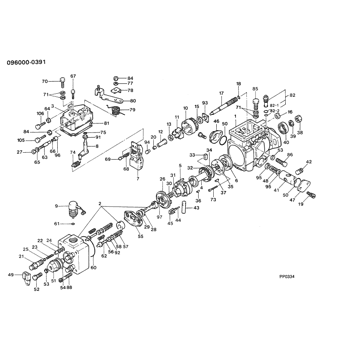Rating:
Information bolt, socket Denso
Include in ##:
09600-00390
as BOLT, SOCKET
Cross reference number
Part num
Firm num
Firm
Name
09644-90110
22395-5635
BOLT, SOCKET
0964490110
22147-54290
TOYOTA
BOLT, SOCKET
0964490110
22395-54263
TOYOTA
BOLT, SOCKET
0964490110
22395-56351
TOYOTA
BOLT, SOCKET
0964490110
22753-54010
TOYOTA
BOLT, SOCKET
0964490110
22395-56351
TOYOTA
BOLT, SOCKET
0964490110
23371-E0010
HINO
BOLT, SOCKET
0964490110
8-97140853-0
ISUZU
BOLT, SOCKET
0964490110
ME736324
MITSUBISHI
BOLT, SOCKET
0964490110
S5A1 13 TD4
MAZDA
BOLT, SOCKET
Information:
Fuel and the Effect from Cold Weather
The two types of diesel fuel recommended for your engine are grades No. 1 and No. 2. Although No. 2 diesel fuel is the most commonly used fuel, No. 1 diesel fuel or a blend of No. 1 and No. 2, is the fuel that is best suited for cold weather operation.During cold weather operation, it may be necessary for you to use No. 2 diesel fuel since quantities of No. 1 diesel fuel are limited and generally are only available in certain areas.There are three major differences between No. 1 and No. 2 diesel fuel.* No. 1 diesel fuel has a lower cloud point. The cloud point is the temperature at which a cloud or haze of wax crystals will begin to form in the fuel and cause fuel filters to plug.* No. 1 diesel fuel has a lower pour point. The pour point is the temperature which diesel fuel will begin to thicken and be more resistant to flow through fuel pumps and lines.* No. 1 diesel fuel has a lower BTU (kJ) (heat content) rating per unit volume of fuel than the average No. 2 diesel fuel. When using No. 1 diesel fuel, you may notice a drop in power and fuel efficiency, but should not experience any other operating effects. Before troubleshooting for low power or poor performance in winter months, check the type of fuel being used.Be aware of these fuel values when purchasing your diesel fuel and anticipate the average outside (ambient) temperature for the area your engine will be operating. Engines fueled in one climate may not operate satisfactorily if moved to another because of problems that result from cold weather.Attachments are available from your Caterpillar dealer to minimize cold weather starting and operation problems. The use of starting aids, engine oil pan heaters, engine coolant heaters, fuel heaters and fuel line insulation also provide a means of minimizing starting and fuel problems in cold weather when No. 2 diesel fuel is used.For further information on cylinder block (coolant) heaters, contact your Caterpillar dealer. The average No. 1 diesel fuel has a lower kJ (BTU) (heat content) rating per unit volume of fuel than the average No. 2 diesel fuel. When using No. 1 diesel fuel, you may notice a drop in power and fuel efficiency, but should not experience any other operating effects.Fuel Related Components in Cold Weather
Fuel Tanks
Store the fuel outside to allow water (condensation) to freeze after separation from the fuel and to indicate any immediate temperature affect on the fuel. Fuel tanks should contain some provision for draining water and sediment from the bottom of the tanks. Some fuel tanks use supply pipes that allow water and sediment to settle below the end
The two types of diesel fuel recommended for your engine are grades No. 1 and No. 2. Although No. 2 diesel fuel is the most commonly used fuel, No. 1 diesel fuel or a blend of No. 1 and No. 2, is the fuel that is best suited for cold weather operation.During cold weather operation, it may be necessary for you to use No. 2 diesel fuel since quantities of No. 1 diesel fuel are limited and generally are only available in certain areas.There are three major differences between No. 1 and No. 2 diesel fuel.* No. 1 diesel fuel has a lower cloud point. The cloud point is the temperature at which a cloud or haze of wax crystals will begin to form in the fuel and cause fuel filters to plug.* No. 1 diesel fuel has a lower pour point. The pour point is the temperature which diesel fuel will begin to thicken and be more resistant to flow through fuel pumps and lines.* No. 1 diesel fuel has a lower BTU (kJ) (heat content) rating per unit volume of fuel than the average No. 2 diesel fuel. When using No. 1 diesel fuel, you may notice a drop in power and fuel efficiency, but should not experience any other operating effects. Before troubleshooting for low power or poor performance in winter months, check the type of fuel being used.Be aware of these fuel values when purchasing your diesel fuel and anticipate the average outside (ambient) temperature for the area your engine will be operating. Engines fueled in one climate may not operate satisfactorily if moved to another because of problems that result from cold weather.Attachments are available from your Caterpillar dealer to minimize cold weather starting and operation problems. The use of starting aids, engine oil pan heaters, engine coolant heaters, fuel heaters and fuel line insulation also provide a means of minimizing starting and fuel problems in cold weather when No. 2 diesel fuel is used.For further information on cylinder block (coolant) heaters, contact your Caterpillar dealer. The average No. 1 diesel fuel has a lower kJ (BTU) (heat content) rating per unit volume of fuel than the average No. 2 diesel fuel. When using No. 1 diesel fuel, you may notice a drop in power and fuel efficiency, but should not experience any other operating effects.Fuel Related Components in Cold Weather
Fuel Tanks
Store the fuel outside to allow water (condensation) to freeze after separation from the fuel and to indicate any immediate temperature affect on the fuel. Fuel tanks should contain some provision for draining water and sediment from the bottom of the tanks. Some fuel tanks use supply pipes that allow water and sediment to settle below the end
